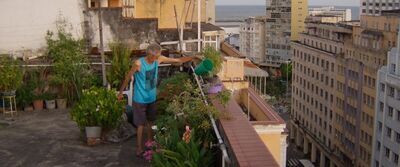
Pictures of Ghosts

The one constant of life is change, and our own individual relations to the place we grew up, or came of age, in are invariably complicated not by just the alterations in the landscape but the way our perspectives shift. Shortly before his death, the great filmmaker Orson Welles wanted to shoot a film based on his real-life experience producing the play The Cradle Will Rock in New York. (The project was brought to fruition many years after Welles’ death, in a film rather disrespectful of Welles directed by Tim Robbins, who had some nerve.) Roger Hill, Welles’ mentor and lifelong friend, asked Welles in a phone conversation whether he’d shoot the thing in Manhattan itself. “I’ve been to New York many times in the past few years, and I have no sense of coming back to a town where I used to live.” This was 1984, when I myself first started living in Manhattan (I moved to Brooklyn sometime later), and now I often don’t entirely recognize the place I called home, because what made it home when I was a whelp just isn’t entirely there anymore.
The Brazilian filmmaker Kleber Mendonça Filho understands this feeling just as well as I and maybe you do, and he’s made a lovely, enveloping film about it, called “Pictures of Ghosts.” The subject here is his hometown of Recife. It’s not a place that looms as large in North American discourse as Rio or San Paolo, but it is a major metropolis in a country that, we ought not forget, is larger than the contiguous United States by a not inconsiderable margin.
While Filho is best known here as co-director of the audacious dystopian 2019 quasi-Western “Bacarau,” his prior feature films are set in Recife and were shot there, on occasion in the apartment in which the 53-year-old director grew up. He divides this documentary into three parts; the first is about his childhood home, with particularly affectionate memories of his mother, a progressive political activist who informed his sensibility and his conscience and who died in her early fifties. He includes clips from the crude horror movies he made as a boy, and the more polished ones he made in his adulthood, and we recognize archways and window in the apartment. He tells the tale of a neighborhood dog, Nico, whose barks on weekend when his people would abandon him would keep his household up. Years later, he hears Nico’s bark again while staying in the old place and wonders if he’s hearing the ghost of the dog. But no: national television is screening Filho’s first feature film, “Neighboring Sounds,” and the residents of another apartment are watching it; Nico has been resurrected by his own film’s soundtrack.
The ghosts of the movie’s title are sometimes particular. There’s a still photo Filho took on a trip around the neighborhood, highlighting an ectoplasmic figure that could be a phantom. And later, transferring analog film to digital, a moving image of a movie theater marquee starts glitching in a way that suggests a coded message. In the movie’s second part, Filho takes us on a tour of Recife’s film culture, mostly by way of now-closed movie theaters, two of the most-missed ones once facing each other across the Capibaribe river. One of them had been set up with German money and was being used to spread Nazi propaganda in the 1930s; dirigibles such as the Hindenburg apparently visited Recife on the regular.
Running still photos and archive footage as his fancy takes him, the director makes wordplay out of marquee titles “’My Name is Nobody’ … ’My Name is Earthquake,’” he intones, conflating the then-now-playing Spaghetti Western with the coming attraction boasted underneath. He interviews a projectionist who screened “The Godfather” in a single theater for a whole month. We may consider that a movie one could never get sick of, the projectionist, Alexandre Moura, begs to differ, at least a little.
Is Filho being sentimental here? As Raymond the butler responds to a similar question in Welles’ “Citizen Kane,” “Yes and no.” “It’s kind of sad to become attached to a product,” the director says at a certain point, but he can’t help but associate the cinema with the church, particularly if the cinema was built on a church, like the still-extant São Luiz theater. On the ground where an 1838 Anglican church once stood, almost a century later, when British influence in Brazil had waned, up went the São Luiz, whose interior is resplendent in Fleur-des-Lis motifs. It’s possible Filho has a hand in running the theater; in a fictionalized coda at the end of the picture, the director takes a cab ride (the scene is slightly reminiscent of something out of Jarmusch’s “Night on Earth”) and tells his driver he manages a movie theater. It looks like one well worth visiting.